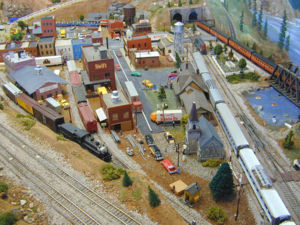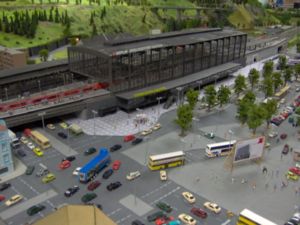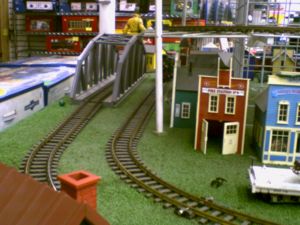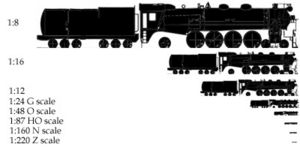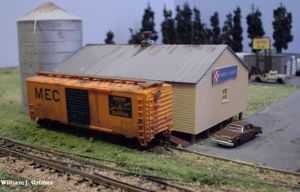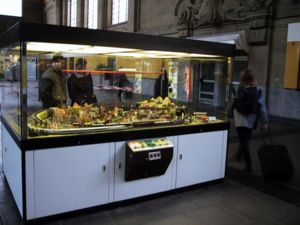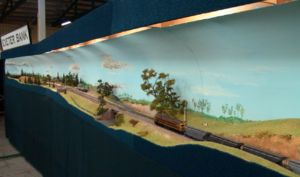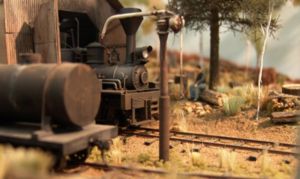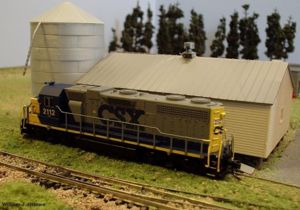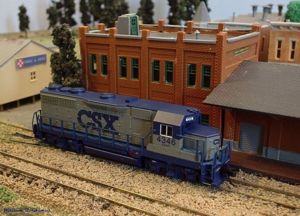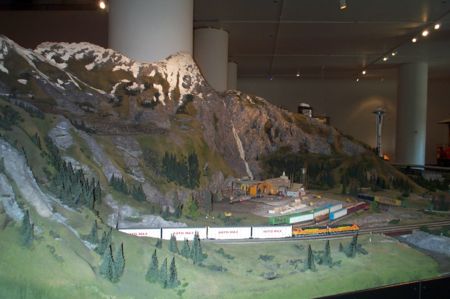Rail transport modelling
Model railroading (US) or Railway modelling (UK) is a hobby in which rail transport systems are modeled at a reduced scale, or ratio. The scale models include rail vehicles (locomotives, rolling stock, streetcars, etc.), tracks, signalling, scenery (roads, buildings, vehicles, model figures, lights, and natural features such as streams, hills, canyons, etc).
The earliest forms of model railways are the 'Carpet Railways' which first appeared in the 1840s. Model trains are generally more realistic than toy trains.
Contents
General description
Involvement in the hobby can range from the possession of a train set to spending many hours and large sums of money on a large and exactingly executed model of a railroad and the scenery through which it passes, called a "layout". Hobbyists, called "model railroaders" or "railway modellers", may even maintain models large enough to ride (see Live steam, Ridable miniature railway and Backyard railroad). Model railroaders may find enjoyment in collecting model trains, building a miniature landscape for the trains to pass through, or operating their own railroad, albeit in miniature.
Some older scale models reach very high prices.
Layouts vary from the very stylistic (sometimes just a simple circle or oval of track) to the "absolutely realistic", where real places are modelled to scale. One of the largest of these is in the Pendon Museum in Oxfordshire, UK, where an EM gauge (same scale as OO but with a more accurate track gauge) model of the Vale of the White Horse as it appeared in the 1930s is under construction. The museum also houses one of the earliest scenic models ever made - the 'Madder Valley' layout built by John Ahern. This latter layout was built in the late 1930s to late 1950s and brought in the era of realistic modelling, receiving coverage on both sides of the North Atlantic in the magazines Model Railway News and Model Railroader during the 1940s and 50s. Bekonscot in Buckinghamshire is the oldest model village, and also includes a model railway, dating from the 1930s onward. The world's largest model railroad track in HO scale is Miniatur Wunderland in Hamburg, Germany, while the largest live steam layout, with over 25 miles (40 km) of trackage is Train Mountain in Chiloquin, Oregon, USA.
Model railway clubs exist where model railway enthusiasts meet. Clubs sometimes put on displays of models for the general public. One rather specialist branch of railway modellers concentrates on larger scales and gauges, most commonly using track gauges from 3.5 to 7.5 inches. Models in these scales are usually hand-built and are powered by live steam, or diesel-hydraulic, and the engines are often powerful enough to haul even dozens of full-scale human passengers. Often model railways of this size are called miniature railways.
One particularly famous model railway club is the Tech Model Railroad Club (TMRC) at MIT, which in the 1950s pioneered the automatic control of track-switching amongst hobbyists by using advanced technology for the time - telephone relays.
The oldest known society is The Model Railway Club (established in 1910), based near Kings Cross, London, UK. As well as building model railways, they also have a library of in excess of 5000 books, periodicals, etc. Similarly, The Historical Model Railway Society is a Society with its Centre of Excellence at Butterley, near Ripley in Derbyshire England. It specialises in Historical railway matters and has considerable archives available to members and non-members alike.
Scales and gauges
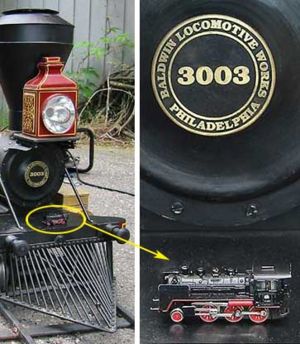
The size of the engines depends on the scale being used and can vary from around 700 mm (28") tall for the largest ridable live steam scales such as 1:8, down to matchbox size for the smallest ones in Z-scale. A typical HO engine is around 50 mm (2") tall, and 100 mm to 300 mm (4" to 12") in length. The five most popular scales used are: G scale, Gauge 1, O scale, HO scale (in Britain, the similarly sized OO is used), TT scale, and N scale, although there is growing interest in Z scale. HO scale is the single most popular scale of model railroad. Popular narrow-gauge scales include HOn3 Scale and Nn3, which are the same scale as HO and N, except with a narrower spacing between the tracks (in these examples, a scale three feet instead of the 4'8.5" standard gauge).
The largest common scale is 1:8, with 1:4 sometimes used for park rides. G scale (Garden, 1:24 scale) is most popular for back yard modelling. It is easier to fit a G scale model into a garden landscape and still keep the scenery proportional to the size of the trains running through. Gauge 1 is also popular for garden layouts. Gauge 1 is more precise to scale than G. O, HO scale, and N scale are more often used indoors. Lionel trains in O scale (1:48 scale) are popular children's toys.
The words scale and gauge seem at first to be used interchangeably in model railways, but their meanings are different. Scale is the model's measurement as a proportion to the original, while gauge is the measurement between the two running rails of the track.
At first, model railways were not to scale. Manufacturers and hobbyists soon arrived at de facto standards for interchangeability, such as gauge, but trains were only a rough approximation to the real thing. See NEM and NMRA. Official scales for the various gauges were soon drawn up, but the scales were not at first at all rigidly followed, and were not necessarily correctly proportioned for the rail gauge chosen. O (zero) gauge trains, for instance, operate on track that is too widely spaced, while the British OO standards operate on track that is significantly too narrow. (The 4mm/1 foot scale on a 16.5mm gauge corresponds to a track gauge of 4' 1 1/2". 7 inches under-sized!) Most of the commercial scales also have standards that include wheel flanges that are too deep, wheel treads that are too wide, and rail tracks that are too large.
Later on, groups of modellers became dissatisfied with these inaccuracies, and developed finescale standards in which everything is correctly scaled. These are used by dedicated modellers but have not generally spread to mass-produced equipment in part because the inaccuracies and overscale properties of the commercial scales are necessary to ensure reliable operation in the hands of consumers as well as experts, and also to allow for shortcuts necessary for cost control. These finescale standards include the UK's S4 (formerly P4) which uses a set of track dimensions scaled near-precisely from the prototype. This 4mm/1 foot modelling uses wheels 2mm (or less) wide running on track with a gauge of 18.83mm. Check-rail and wing-rail clearances are similarly accurate.
Landscaping

Some modellers pay special attention to landscaping their model layout, creating either a fantasy world, or closely modelling an actual location, often a historic one, which does not exist anymore. Landscaping is also termed "scenery building" or "scenicking."
Constructing scenery generally involves preparing a sub-terrain using screen wire, a lattice of cardboard strips, or carved stacks of expanded polystyrene (styrofoam) sheets. A scenery base is then applied over the sub-terrain; typical scenery base materials include casting plaster, plaster of Paris, hybrid paper-pulp (papier-mâché) or a lightweight foam/fiberglass/bubblewrap composite as in Geodesic Foam Scenery. The scenery base is covered with ground cover, which may be made from ground foam, colored sawdust, natural lichen, or commercial scatter materials for grass and shrubbery. Buildings and structures can be purchased as kits, or hand fabricated ("scratch built") from cardboard, balsa wood, basswood, or polystyrene or other plastic sheet. Trees can be fabricated from natural materials such as Western sagebrush, candytuft, and caspia, to which an adhesive and model foliage are applied. Water can be simulated using polyester casting resin, polyurethane, or rippled glass. Rocks can be cast in plaster or in plastic with a foam backing. Castings can be painted with stains to give realistic coloring and shadows.
Weathering
Most models come out of the packet looking new, because unweathered finishes are easier to produce and many collectors want their display models to look pristine. However, the practice of weathering models, simulating the natural dirt and wear on vehicles, structures and equipment, is very common. Weathering typically aims to reduce the plastic-like finish of scale models and well-weathered models can be nearly indistinguishable from their prototypes when photographed appropriately.
Methods of power
Model railway engines are generally operated by low voltage DC electricity supplied via the tracks, but there are exceptions, such as Märklin and Lionel Corporation, which use AC.
Most of the early models made for the toy market were powered by clockwork and controlled by stop/go and reverse levers on the locomotive itself. Although this made control crude the models were of large enough scale and robust enough that grabbing the controls as they ran around the track was quite practical. Various manufacturers also introduced slowing and stopping tracks that could trigger levers on the locomotive and allow reliable station stops to be performed. Other locomotives, particularly large models used actual steam. Steam or clockwork driven engines are still sought by collectors.
Early electrical models used a three-rail system with the wheels resting on a metal track with metal sleepers that conducted power and a separate middle rail which provided power to a skid under the locomotive. This at first apparently strange arrangement made sense at the time as the majority of materials used for railway models were metal and conductive. Modern plastics were not yet available and insulation was therefore a significant problem. In addition the notion of accurate models had yet to evolve and toy trains and track were generally crude tinplate representations of generic models.
As model accuracy became more important some model systems adopted two rail power where the wheels were isolated from each other and the two rails carried the positive and negative supply or the two sides of the AC supply. Other model systems such as Märklin instead used a set of fine metal studs to replace the central rail, allowing existing three rail models to use more realistic track.
Although DC power with the positive and negative charges on the two rails is the most common method of power, Märklin and Lionel use AC power on the three rail system. American Flyer is another exception, which used AC power on two-rail track.
Early electric trains ran on battery power, because few homes in the late 19th and early 20th centuries were wired for electric power. Today, inexpensive train sets running on battery power are once again becoming more common, but these are generally regarded as toys and are seldom used by hobbyists. Battery power is also used by many garden railway and larger scale systems both because of the difficulty in obtaining reliable power supply through the rails when outdoors and because the high power consumption and thus current draw of large scale garden models is more easily and more safely met with lead acid batteries.
Engines powered by Live steam are often built in large, outdoor gauges, and are also readily available in G scale, 16 mm scale and can be found in O and HO scale. Hornby Railways produce a range of live steam locomotives in OO scale, development of work by some very dedicated modellers who hand-built live steam models in HO/OO, OO9 and N, and there is even one in Z in Australia.
Occasionally the topic of gasoline-electric models, patterned after real-life diesel-electric locomotives, comes up among dedicated hobbyists; and companies like the Pilgrim Locomotive Works have sold such locomotives commercially. Large-scale petrol-mechanical and even petrol-hydraulic models are commercially available but these are unusual and significantly pricier than the more usual electrical power.
Control
The first clockwork (spring-drive) and live steam locomotives simply ran until they ran out of power, with no way for the operator to stop and restart the locomotive or to vary its speed. The advent of electric-powered trains, which first appeared commercially in the 1890s, allowed one to control the train's speed by varying the current, or voltage. As trains began to be powered by transformers and rectifiers more sophisticated throttles appeared, and soon trains powered by AC started containing mechanisms that caused the train to change direction and/or even go into a neutral gear when the operator cycled the power. Trains powered by DC can change direction simply by reversing polarity.
Electric power also permits control by dividing the layout into electrically isolated blocks, where trains can be slowed or stopped by lowering or cutting the power to a block. Dividing a layout into blocks also permitted operators to run more than one train on a layout with much less risk of a fast train catching up with and hitting a slow train. Blocks can also trigger signals or other animated accessories on the layout, adding more realism (or whimsy) to the layout. Three-rail systems will often insulate one of the common rails on a section of track, and use a passing train to complete the circuit and activate an accessory.
Many modern day model railways use digital techniques and are computer controlled. The industry standard command system is called Digital Command Control, or DCC. Some less-common closed proprietary systems also exist.
In the large scales, particularly for garden railways, the use of radio control and DCC in the garden has become popular.
Model Railway Manufacturers
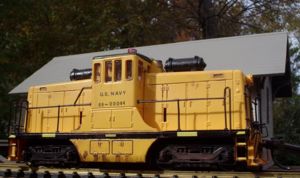
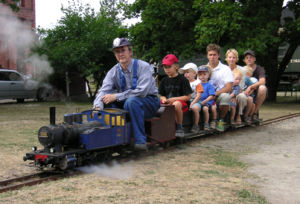
- Accurail Inc.
- Accucraft Trains
- Atlas Model Railroad Co.
- Airfix
- American Flyer
- Arnold
- AR Kits
- Aristo-Craft Trains
- Athearn
- Atlas Model Railroad
- Auscision
- Austrains
- Bachmann Industries
- Bassett Lowke
- Bergs
- Brawa
- Berliner Bahn
- Bing (Germany)
- BLMA Models
- Bowser Manufacturing, Montoursville PA
- Branchline
- Brimalm Engineering
- Broadway Limited Imports (BLI)
- Dapol
- Electrotren
- Eureka Models Australia
- Exley
- Faller
- Ferris (obsolete)
- Fleischmann
- Greenmax
- G .& R. Wrenn Ltd
- Graham Farish ("Grafar")
- Hanovale Australia
- Herpa
- Hornby
- Ibertren
- InterMountain]
- Internation Hoby Corporation - (IHC)
- Jouef - (France)
- Ke-Wiz Australia
- Kawai
- Kato
- Kemtron Corporation, Fresno CA (defunct 1964)
- Klein Modellbahn
- Lehmann Gross Bahn
- Life Like
- Liliput
- Lima
- Lionel
- Marx
- Mantua, later Tyco Toys
- Märklin
- Mainline
- Mehano
- Micro Ace
- Micro-Trains Line Co.
- Modemo - (Hasegawa)
- MTH Electric Trains
- NMJ, Norsk Modelljernbane
- Ozfreight
- Peco
- Piko
- Playcraft
- Playmobil
- President's Choice
- Rapido
- Ratio
- Rivarossi
- Roco
- Rokal
- Steam Era Modelling - (SEM)
- Stewart Hobbies
- Tomix
- Tillig
- Trainorama
- Tri-ang Railways
- Trix/Minitrix
- Trainorama Australia
- USA Trains
- Varney
- Vollmer
- Wiking
- Walthers
- Woodland Scenics
- Worsley Works Etched model railway kits from 2mm -16mm
- Wuiske Promotions. Suppliers of Queensland Rail kits in HO and HOm Scales.
Famous Model Railroaders
Famous within the model railroad press
- John Allen
- John Armstrong
- David Barrow
- Bruce Chubb
- Walt Disney
- Frank Ellison
- Ollie Johnston
- Al Kalmbach
- Jim Kelly
- Ward Kimball
- Tony Koester
- W. Allen McClelland
- David Popp
- David Rose
- Iain Rice
- Cliff Robinson
- George Sellios
- Whit Towers
- Wayne Wesolowski
- Linn H. Westcott
- Bill Wight
Other famous model railroaders
- Gary Coleman (N scale modeler and part owner of Caboose Hobbies in Denver, Colorado)
- Whoopi Goldberg
- Hermann Göring (rumored to have had a large Märklin model railway)
- Michael Gross
- Tom Hanks
- Sam Posey
- Frank Sinatra (Lionel and tinplate collector)
- Rod Stewart
- Tom Snyder
- Pete Waterman
- Anders Wejryd, Archbishop of Church of Sweden
- Neil Young (part owner of Lionel Trains)
- Rev. W. V. Awdry, author of the Railway Series
Fictional model railroaders
- Gomez Addams (The Addams Family) had a Lionel layout. He was noted for setting trains on a collision course, then blowing them up with explosives.
- Richard Channing (Falcon Crest) had a model railroad in his office.
- Reverend Timothy Lovejoy (The Simpsons) has been portrayed in several episodes running model trains in his basement.
- John Patterson (For Better or For Worse) has a garden railroad.
- Mr X & his archenemy Glowface {The X's} are model trains fanatics.
- Mary Ellen Rogers (Leave it to Beaver), (Wally's Girlfriend)'s Dad has an American Flyer layout in her basement in one episode.
- King Willem (Double Star). His love of model trains, and the protagonists failure to simulate amusement with same, is a plot point in the story.
- Joe Heffernan, Doug's Father on The King of Queens entered a competition in one episode.
- Bobby Baccalieri (The Sopranos) has a layout in his garage.
Layout Standards Organizations
Several organizations exist to set standardizations for connectability between individual layout sections (commonly called "modules"). This is so several (or hundreds, given enough space and power) people or groups can bring together their own modules, connect them together with as little trouble as possible, and operate their trains. Despite different design and operation philosophies, different organizations have similar goals; standardized ends to facilitate connection with other modules built to the same specifications, standardized electricals, equipment, curve radii.
- NTRAK (Website). Standardized 3-track (heavy operation) mainline with several optional branchlines. Focuses on Standard Gauge, but also has specifications for [arrow Gauge. Due to its popularity, it can be found in regional variations, most notably the Imperial-to-Metric measurement conversions. Tends to be used more for 'unattended display' than 'operation'.
- FREMO (Deutsche English). A European-based organisation focusing on a single-track line, HO Scale. Also sets standards for N Scale modules. Standards are considerably more flexible in module shape than NTRAK, and has expanded over the years to accommodate several scenery variations.
- oNeTRAK (Website). Operationally similar to FREMO, standardises around a single-track mainline, with modules of varying sizes and shapes. Designed with the existing NTRAK spec in mind, is fully compatible with such modules.
- ausTRAK (Website). N Scale, two-track main with hidden third track (can be used as NTRAK's third main, as a return/continuous loop, or hidden yard/siding/on-line storage). Australian scenery and rolling stock modelled in Standard Gauge.
- NMRA ([1]) National Model Railroad Association
The National Model Railroad Association is the largest organization devoted to the development, promotion, and enjoyment of the hobby of model railroading.
See also
| Rail transport |
|---|
| Operations |
| Stations |
| Trains |
| Locomotives |
| Rolling stock |
| History |
| Terminology |
| By country |
| Disasters |
|
|
- Standard gauge in Model railways
- The Toy Train Depot - A museum dedicated to the history of scale model railroading in Alamagordo, New Mexico
- San Diego Model Railroad Museum
External links
- The National Model Railroad Association, USA
- The San Diego Model Railroad Museum The world's largest indoor model railroad exhibit
- www.bstrailroad.com Gary Courtemanche's Blood Sweat and Tears Railroad
- rmweb2.co.uk - UK based railway modelling forum
- The Gauge - US based railway modelling forum
- New Railway Modellers - Beginners model railway website.
- Railpage Australia Discusion group on everything to do with Australian railways including model railways
- iRail - UK / Ireland Model Railway & Railway Web Directory Index of all railway and model railway related websites in the UK and Ireland.
- Roadside America
- [2] This model railway in Hamburg, Germany, claims to be the world's largest.
- LOXX Berlin, in Berlin, Germany, also claims to be the world's largest model railway in HO scale.
- Klein Modellbahn, Vienna, Austria (in German only)
- Canadian Association of Railway Modellers
- Récréations scientifiques: Un petit chemin de fer électrique, article in French magazine, La Nature, p. 32, vol. 28 (spring 1887), perhaps the earliest example of an electric rail transport toy
- Railways of Germany forum An English speaking forum about the railways of Germany
- ScaleModel.NET International List of Scale Model Related Web Sites.
- The Model Railway Club The oldest known society in the World - established 1910.
- DCC Wiki A DCC Wiki community for all scales and manufacturers.
- 3mm Society Web Site (UK)
- Modelljernbaneforeningen i Norge / Model Railway Association of Norway
- Layout Design SIG NMRA Layout Design Special Interest Group.
| Wikimedia Commons has media related to: Rail transport modelling |
- Greenwich and District Narrow Gauge Railway Society
- ExpoNG
- www.myhobbymodels.com Articles on railway modelling
Model railroading print and media sources
- Australian Model Railway Magazine Australian orientated model railway magazine published bimonthly
- Model Railroader Magazine General model railroading for all scales. Model Railroader has the largest circulation of any model railroading general interest magazine in the hobby.
- Railroad Model Craftsman Magazine General model railroading for all scales. Railroad Model Craftsman has the second largest circulation of any general interest magazine in the hobby.
- Model Railroading Magazine General model railroading for all scales.
- Rail Model Journal General model railroading for all scales.
- Mainline Modeler Magazine General model railroading for all scales, with an emphasis on scratchbuilding.
- Allen Keller video Allen Keller's Great Model Railroads series documents the leading model railroad layouts.
- Great Layouts video Video tours of some of the best model railroads in Australia.
- Model Trains Video How to videos presenting expert model railroading techniques.
- "Railway Modeller" and "Continental Modeller", both published by Peco
